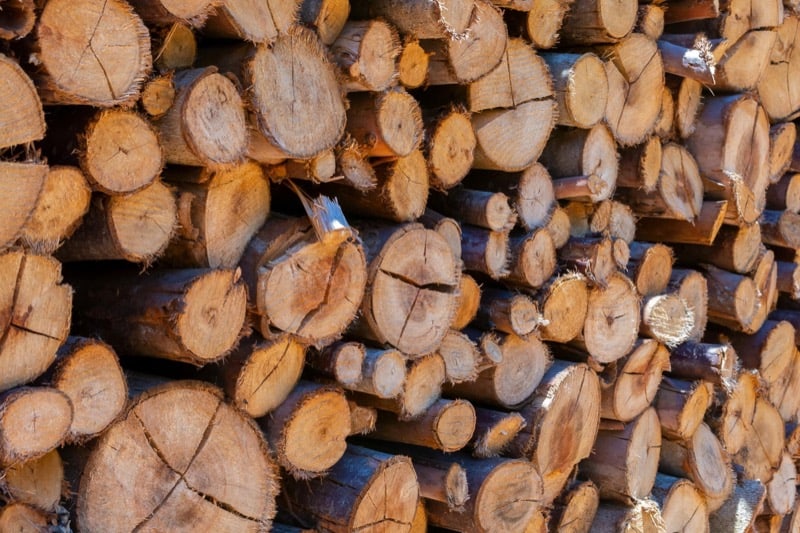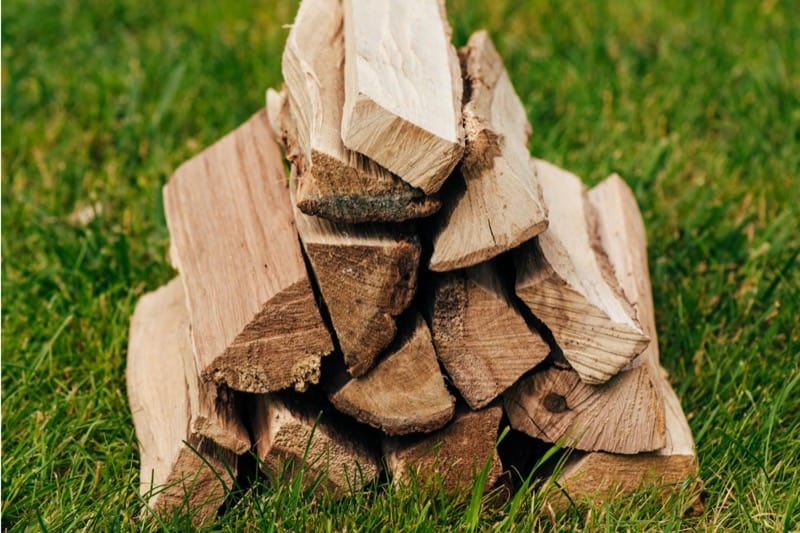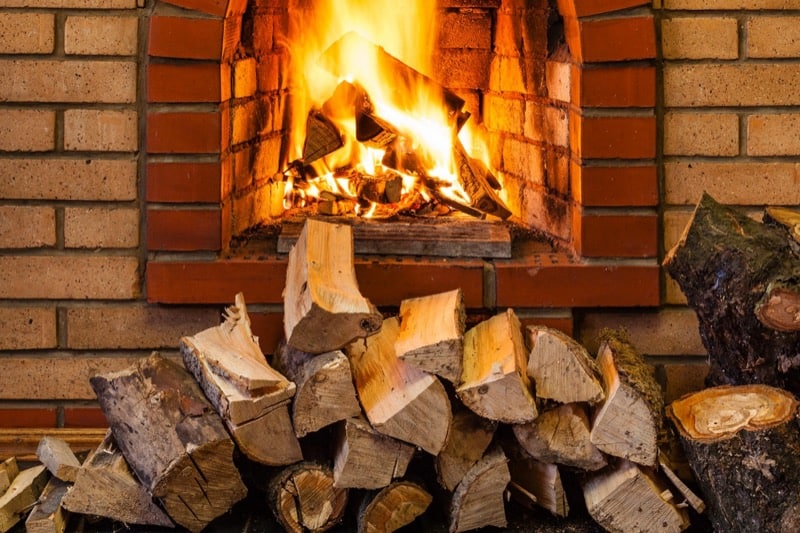If you have a fireplace, a fire pit, or a wood-burning stove or oven, and need to acquire firewood, vendors may speak to you about a rick, cord, or even a quarter cord of wood when looking to purchase your firewood supply.
A term that is commonly used commercially by retailers selling firewood is a “rick of wood.” But what is a rick of wood exactly?
This article will cover rick of wood, cord of wood, different types of wood, costs, and much more.
What Is a Rick of Wood?
A rick of wood is a load of stacked firewood that measures eight feet in length and four feet in height (4 feet high x 8 feet long).
Depending on who your firewood supplier is, width measurements will vary. Widths can be influenced by the supplier, the area or region you reside in or be based on local supply and demand.
Rick of Wood vs. Cord of Wood
A cord of wood can have several ricks of wood in it. Exactly how many ricks are in a cord of wood depends on the width of the single ricks. A rick could be 1/2 or 1/3 of a cord of firewood.
The terminology “rick of wood” describes a pile or stack of firewood that measures four feet high by eight feet long. The width of the rick varies by the supplier.
If you’re offered a twelve-inch rick of firewood, all the logs in this wood stack will be twelve inches in length. The most common length for fire logs, however, is approximately sixteen inches.
The term “face cord” is another way of saying rick of wood. Ricks or cords can feature one of several lengths of wood. You may find a rick of wood that has 12-inch, 16-inch, or 24-inch wood pieces. These refer to the lengths of the individual logs in the rick of wood.
A “cord of wood” is also a stack of wood, and it too will measure eight feet in length, and four feet in height. But it will also measure four feet in width. The cord will have a volume of 128 cubic feet – 4 feet tall x 8 feet long x 4 feet wide.
The rick of wood and the cord of wood have the same height and length. It is the difference in width that distinguishes them. A rick is a fraction or part of a cord of wood.

Where Does “Rick” Come From?
The Oxford Dictionary indicates that the etymology of the word “rick” dates back to Old English and derives from the word hrëac, which signifies a stack or a pile. It was used in reference to agricultural materials like corn, wood, hay, or others.
With the historical migration to North America, the word came with settlers and is still heard in the Midwest region of the United States.
How Much Does a Rick of Wood Weigh?
How much a rick of wood will weigh will depend on the size chosen and on the type of wood you select. Many kinds of wood are heavier, like oak, both white and red. Heavier firewood can easily amount to roughly 5500 lbs. or two and a half tons for a single cord of wood.
Spruce wood, which is lighter, can easily weigh in at approximately 2500 lbs. or a ton and a quarter of a full cord of wood.
Depending on the log length you select, your wood can weigh anywhere from about 625 lbs. to approximately 3000 lbs.
How Many Logs Are in a Rick of Wood?
Usually, a rick of wood will contain pieces of firewood and not logs. On average, there may be approximately 275 to 325 seasoned pieces of wood in a rick. The difference will depend on how tightly the rick has been stacked and how efficiently wood pieces have been cut.
Since different retailers will tie their ricks a little differently, it’s always best to ask your retailer how many pieces are generally included in the ricks that they sell.
Should the wood not be split, the number of logs in a rick will depend on its length. 16-inch logs stacked 4 by 8 feet should be equivalent to 1/3 of a cord, while 24-inch logs should equal about 1/2 of a cord.
Cords of firewood are 128 cubic feet, while a rick is not an exact measurement and can vary a bit. The length of firewood logs will define how much wood you receive. Because suppliers generally cut the wood into 16-inch lengths, an approximate estimate would be that a rick of wood provides you with a third of a cord.
Another way to estimate the measurement of firewood and how many logs you’ll have is that a rick of wood can generally fit in the bed of a pickup truck. But a cord of firewood will usually take 2 to 3 pickup trucks.
How Much Does a Rick of Wood Cost?
Cost depends a great deal on where you reside and who your commercial retailer is. If you select a face cord or rick of oak, budget between $150 and $250 for your purchase.
However, several factors can influence prices of firewood for sale. Among the common factors:
- The kind of wood you select (maple, oak, black locust, etc.).
- If the wood is seasoned. Seasoned wood usually takes 6 to 12 months.
- The method used for seasoning (kiln-dried or air-dried).
- Local supply and demand.
When you consider all of these factors, you’ll get a general range of costs for your firewood supply. Estimate that you’ll be paying top dollar and budget accordingly. In this way, you’ll get the amount you need, and with a bit of luck, spend a little less.
You may be able to save some money if you have a pickup truck and can pick up your own wood. This will save you the added cost of transportation and delivery.
Transportation fees can run as high as $2 for every mile. Some retailers may only charge transport fees if you need your wood delivered beyond a certain distance. If you are a new client, ask if your wood supplier will throw in the delivery for free.
Some commercial retailers may offer free delivery for certain quantities of firewood purchased. You can check to verify what local retailers are asking for a rick of wood and if that cost includes delivery or not. When you are budgeting for firewood, remember to consider that you may have to pay delivery fees.
Firewood vendors may also include a “stacking fee,” while a few may offer this service for free. If you don’t want to stack your own wood, inquire to see if stacking is included and if there is a fee attached. There may also be retailers that do not stack wood at all, so make sure to ask before concluding your purchase. Stacking fees may run you an extra $20 to $30 easily.
How Many Ricks of Wood Do I Need?
Unfortunately, there is no correct answer to this question. A lot depends on how much wood you consume. Generally speaking, a single rick will not be adequate for a medium-sized house for an entire winter.
You might make it through winter with two ricks, but this will depend on your heating requirements and house size. Three should be sufficient though.
How Long Does a Rick of Wood Last?
If firewood is your primary source of heat, and you need to heat your entire home for the winter, the average rick may last somewhere from six to ten weeks.
But this will be influenced by the average temperature you maintain, how well your home is insulated, and how low winter temperatures drop. So, always plan on buying more rather than less.

How to Store Your Firewood
Storing your firewood properly is just as important as purchasing it. Buying firewood is expensive, so proper storing will protect your investment. If your firewood has been delivered but has not been stacked for you, it will be up to you to stack it in your preferred location.
When you select the location, keep in mind that it should be conveniently located so you can get to it in the event of extreme winter weather. Ideally, it should be kept covered as well.
If the wood delivered hasn’t been split, this will be your first chore. Wood should be split into manageable pieces so that you can carry it with ease, and so it burns more readily when used.
If the wood is still green or wet, you will need to stack it in an open area with good air circulation so that it will continue to dry when stacked. Dry wood is essential to healthy, proper burning. Green wood will generate large amounts of smoke and creosote, which can turn deadly.
How well your wood dries will depend on your stacking prowess. Also, the wood must be stacked in such a way that it is off the ground. You can use logs, bricks, or pallets, to keep it raised. And put the driest wood at the top for easy access.
The most common stacking method is in rows. Some people use stakes at the pile ends or secure wood stacks by cross tying. An effective way to cross tie is to chop wood into several square pieces. These are used at the ends to keep wood in place and from rolling or sliding off.
It is highly recommended that you do not stack firewood between two trees as trees will move naturally, causing your firewood to topple over.
Two other methods used are heap piling and circle piling. If you need to stack in more than a single row, leave space for air circulation between rows so that your wood remains dry. If your wood is stacked too tightly, it can retain moisture.
You can invent a method for stacking firewood as long as it remains tidy and has good air circulation.

Racks, Holders, and What to Burn
Racks and holders may make your firewood conservation easier and more organized. Even better, they can be used indoors, as well as in an outdoor shed or a garage if you have enough space.
Inside your home, it is recommended that you only keep enough wood for a couple of days to avoid unwanted pest infestations, as well as dirt and pollen from invading your living space. Wood brought indoors should be completely dry to avoid bringing moisture into your home, too.
When burning, only burn dried wood, as burning green or wet wood will create undesirable smoke. When collecting wood from your stack for burning, select some of the oldest wood to avoid it rotting when left for long periods. Ideally, you will want to consume your entire rick to avoid leftover wood because of the risk of rotting.
Rick of Wood Final Thoughts
There are many ways to buy, store, and conserve your firewood. It is up to you how you choose to go about doing it. The important thing is that you take care of your firewood, and ensure that it lasts for years to come.
Your new wood supply will heat your home and add atmosphere and the fragrant aroma of crackling wood while keeping you and your family toasty warm.
Here are other articles you might be interested in:

